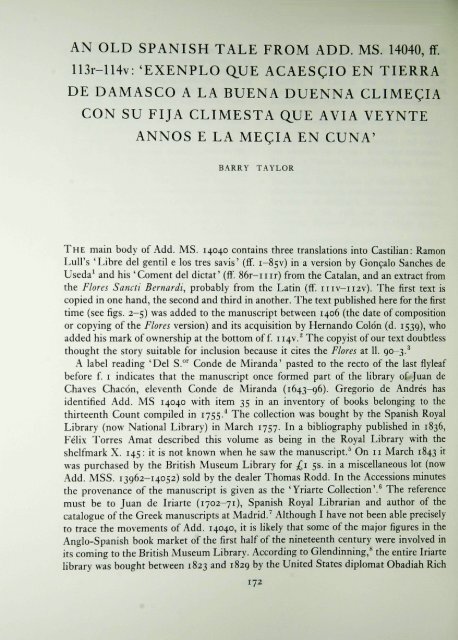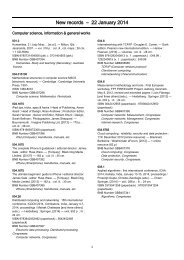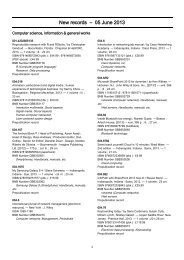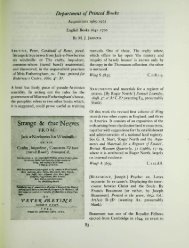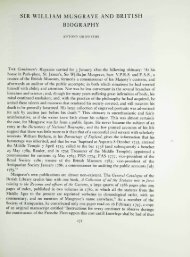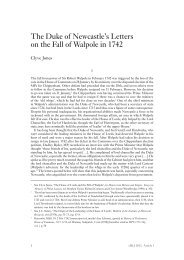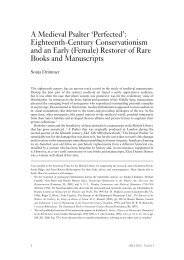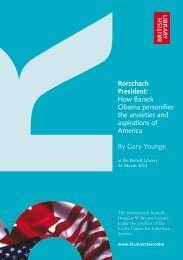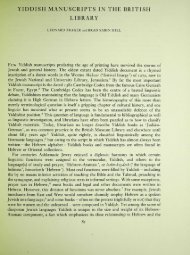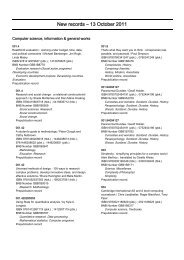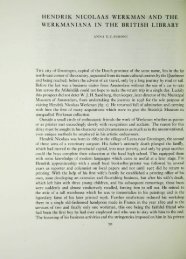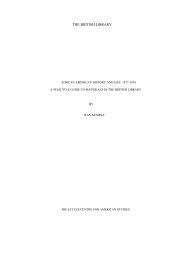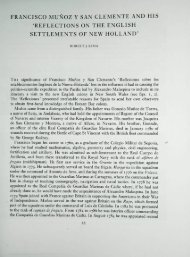AN OLD SPANISH TALE FROM ADD. MS. 14040, flf ... - British Library
AN OLD SPANISH TALE FROM ADD. MS. 14040, flf ... - British Library
AN OLD SPANISH TALE FROM ADD. MS. 14040, flf ... - British Library
You also want an ePaper? Increase the reach of your titles
YUMPU automatically turns print PDFs into web optimized ePapers that Google loves.
<strong>AN</strong> <strong>OLD</strong> SP<strong>AN</strong>ISH <strong>TALE</strong> <strong>FROM</strong> <strong>ADD</strong>. <strong>MS</strong>. <strong>14040</strong>, <strong>flf</strong>.<br />
113r-114v: 'EXENPLO aUE ACAESgiO EN TIERRA<br />
DE DAMASCO A LA BUENA DUENNA CLIME^IA<br />
CON SU FIJA CLIMESTA QUE AVIA VEYNTE<br />
<strong>AN</strong>NOS E LA MEgiA EN CUNA'<br />
BARRY TAYLOR<br />
THE main body of Add. <strong>MS</strong>. <strong>14040</strong> contains three translations into Castihan: Ramon<br />
Lull's 'Libre del gentil e los tres savis' (ff. 1-85V) in a version by Gon^alo Sanches de<br />
Useda^ and his 'Coment del dictat' (ff. 86r-iiir) from the Catalan, and an extract from<br />
the Flores Sancti Bernardi, probably from the Latin (ff. iiiv-ii2v). The first text is<br />
copied in one hand, the second and third in another. The text published here for the first<br />
time (see figs. 2-5) was added to the manuscript between 1406 (the date of composition<br />
or copying ofthe Flores version) and its acquisition by Hernando Colon (d. 1539), who<br />
added his mark of ownership at the bottom off. ii4v.^ The copyist of our text doubtless<br />
thought the story suitable for inclusion because it cites the Flores at 11. 90-3.^<br />
A label reading 'Del S.^"^ Conde de Miranda' pasted to the recto ofthe last flyleaf<br />
before f. i indicates that the manuscript once formed part of the hbrary of Juan de<br />
Chaves Chacon, eleventh Conde de Miranda (1643-96). Gregorio de Andres has<br />
identified Add. <strong>MS</strong> <strong>14040</strong> with item 35 in an inventory of books belonging to the<br />
thirteenth Count compiled in 1755.'* The collection was bought by the Spanish Royal<br />
<strong>Library</strong> (now National <strong>Library</strong>) in March 1757. In a bibliography pubhshed in 1836,<br />
Felix Torres Amat described this volume as being in the Royal <strong>Library</strong> with the<br />
shelfmark X. 145: it is not known when he saw the manuscript.^ On 11 March 1843 it<br />
was purchased by the <strong>British</strong> Museum <strong>Library</strong> for £1 5s. in a miscellaneous lot (now<br />
Add. <strong>MS</strong>S. 13962-14052) sold by the dealer Thomas Rodd. In the Accessions minutes<br />
the provenance of the manuscript is given as the 'Yriarte Collection'.^ The reference<br />
must be to Juan de Iriarte (1702-71), Spanish Royal Librarian and author of the<br />
catalogue ofthe Greek manuscripts at Madrid.^ Although I have not been able precisely<br />
to trace the movements of Add. <strong>14040</strong>, it is likely that some ofthe major figures in the<br />
Anglo-Spanish book market ofthe first half of the nineteenth century were involved in<br />
its coming to the <strong>British</strong> Museum <strong>Library</strong>. According to Glendinning,^ the entire Iriarte<br />
library was bought between 1823 and 1829 by the United States diplomat Obadiah Rich<br />
172
(1783-1850) from 'a French officer married to the last surviving heir ofthe family';<br />
Thomas Thorpe was often his agent. Both Thorpe's and Rich's Spanish books were<br />
auctioned by Evans on 2 March and 4 July 1826 respectively. The connection between<br />
Thorpe, Rodd and the Iriarte collection is documented on 5 June 1826 when Thorpe<br />
sold Rodd 117 volumes from Iriarte's library which eventually passed via Richard Heber<br />
to the Bodleian. Thus, although the history ofthe ownership of Add. <strong>14040</strong> is far from<br />
complete, it seems unlikely that the manuscript was in the Biblioteca Real as late as 1836,<br />
the date of publication of Torres Amat's catalogue.<br />
Our text is called exenplo in the rubric which heads it, and indeed it displays the<br />
mixture of the didactic and the grotesquely sensational which characterizes one current<br />
within the exempluni genre. The plot may be summarized as follows. In Damascus during<br />
the reign of the fictional Emperor Sixtus, a noble lady Climegia and her daughter<br />
Climesta fall on hard times through the profligacy of their husband and father. The<br />
daughter, aged twenty (her age is given only in the rubric), is a worldling, proud ofher<br />
beauty. The women initially heed the exhortations of the hermit Patri^io against losing<br />
their souls for the sake of worldly gains. The hermit reinforces his admonitions with a<br />
brkfexemplum: Falsehood asked Truth where she might find her. Truth replied that if<br />
Falsehood found her, she should keep hold of her, as if she let her go she would never<br />
have her back.<br />
Mother, however, is advised by evil persons that the world will bring them all they<br />
need if she 'rocks' herself and her daughter. She accordingly buys two cradles, to no<br />
avail. A woman neighbour (the Devil in disguise) disabuses them: this 'rocking' is a<br />
euphemism for prostitution. They persevere in a life of vice despite Patri^io's warnings.<br />
Eventually Climesta is caught inflagrante and sentenced to be burned. On her way to the<br />
stake she asks to speak to her mother: when she draws near, the daughter bites off her<br />
tongue and puts her eyes out. Asked why, she says it is because she has been ruined by<br />
her mother's ill advice and failure to give her good counsel.<br />
Climesta's grotesque punishment ofher mother is an example of a tale found in many<br />
didactic texts.^ Probably the oldest version known is in the Greek Aesop :^^ a boy steals<br />
a book from a schoolmate as a joke. His mother laughs at his prank, which encourages<br />
him to go on to worse crimes. Eventually he is sentenced to be hanged; on the way to<br />
the scaffold, under pretence of whispering to his mother, he bites off her ear (see fig. i).<br />
He explains his action by saying that her indulgence was the cause of all his crimes: had<br />
she punished him at his first offence, he says, he would never have come to such a pass.<br />
The Aesopic text seems not to have entered Latin circles until Rinuccio d'Arezzo's<br />
1448 translation. The version in Pseudo-Boethius, De disciplina scolarium, dated circa<br />
1240, was known earher, and more widely, to the Latins: several manuscripts have<br />
English and French glosses, suggesting that they were used for teaching grammar.^^<br />
There Lucretius, son of Zeno,^^ wastes the advantages of good birth, talent and<br />
patrimony on prostitutes. His father stands by ('patre poenam deferente'). The youth<br />
turns to crime to pay his debts, and is saved from crucifixion because his father bribes<br />
the authorities. Finally father can pay no more. On the way to execution the son bites<br />
173
Fig. I. The errant son bites his mother's ear. Libro delsabio £5" clarissimo fabuladorysopo hystoriad<br />
£5' annotado (Seville: Cromberger, 1526). C.59.i.i6, f. clvi""<br />
Text<br />
Aesop (see fig. i)<br />
Odo of Cheriton'^<br />
Ps-Boethius<br />
Jacques de Vitry^*<br />
Etienne de Bourbon'^<br />
Libra del caballero<br />
Spanish woodcut*'<br />
Climefia<br />
TABLE L VARI<strong>AN</strong>TS<br />
Dale<br />
c. 1220<br />
c. 1240<br />
d. 1240<br />
d. 1261<br />
Parent<br />
Mother<br />
Father<br />
Father<br />
Father<br />
Father<br />
Mother<br />
^- 1303<br />
1488<br />
Mother<br />
copied post 1406 Mother<br />
OF THE CLIMEgiA STORY<br />
Child Crime Punishment Bitten<br />
Son<br />
Son<br />
Son<br />
Son<br />
Son<br />
Son<br />
Stealing<br />
Hanging<br />
Stealing, immorality Hanging<br />
Fornication Crucifixion<br />
Stealing<br />
Hanging<br />
Stealing<br />
Stealing, etc.<br />
Hanging<br />
Son —<br />
Daughter Fornication<br />
Burning<br />
Eai'<br />
Flesh of face<br />
Nose<br />
Lips<br />
Nose<br />
Lips<br />
Nose<br />
Tongue, eyes<br />
off his father's nose. His last words blame first his father's indulgence and then his own<br />
disobedience: 'Why did I escape unpunished from my first errors.? Why did I not obey<br />
my first teacher and despise my fellows.^' In subsequent derivatives of this story, the<br />
protagonists, crime, punishment and mutilation differ, as is shown in Table i.<br />
It will be seen from the Table that the story in Add. <strong>MS</strong>. <strong>14040</strong> does not correspond<br />
174
in all particulars with any other known version. One feature of our texts is the feminine<br />
element: the child is a daughter who engages in prostitution rather than a son who<br />
consorts with prostitutes. The inclusion of a daughter enables the author to descant on<br />
the theme of women's vanity (11. 17-22): Chmesta from the start is guilty of excessive<br />
care for her appearance - a theme beloved of medieval preachers - and although the<br />
connection between female luxury and prostitution is not made explicit, they are<br />
certainly referred to in similar terms: see 11. 13-15.<br />
Patrigio's tale ofthe exchange between Truth and Falsehood is not unique to this text,<br />
although it has fewer parallels than the main story. The only close analogue is in the Libra<br />
del caballero Zifar of circa 1303.^^ When Wind, Water and Truth part company, they ask<br />
each other where he is to be found. Water says he will be in the fountains. Wind in the<br />
mountain passes. Truth replies: 'Keep me while you have me, as once you let me go<br />
you'll never catch me again.' The version in Zifar is superior to that in our manuscript,<br />
as it integrates Truth's answer into a tripartite structure in which Truth is declared even<br />
harder to keep hold of than the ungraspable Wind and Water. It is interesting that the<br />
only work to include both the stories in our text appears also to be an Old Spanish one.<br />
The immediate source of our text is unknown, but it seems likely that it is a<br />
translation, partly because one episode is built around a pun on mefer, 'to rock in a<br />
cradle/be a prostitute.' The pun is unique to this version. The second meaning of mefer<br />
is not to my knowledge attested in Old Spanish, although it does exist in modern<br />
Portuguese mexer}^ In Latin however the sexual meaning of miscere (the supposed<br />
etymon of mefer) is well established.^*' The text shows some signs that it is a fragment.<br />
The first three sentences refer not only to Climegia and her daughter Climesta but also<br />
to Clime^ia's sister Gloriana and her son Picleco. Parents are exhorted to learn from<br />
'these two sisters,' which suggests that an earher witness preserved a parallel story,<br />
perhaps a tale of virtue rewarded. However, in the extant text no more is heard of<br />
Gloriana and Picleco.<br />
EDITION OF THE TEXT IN <strong>ADD</strong>. <strong>MS</strong>. <strong>14040</strong><br />
[f. ii3r] Exenplo que acaes^io en tierra de Damasco a la buena duenna Climefia con su<br />
fija Climesta que avia veynte annos e la megia en cuna.<br />
En la ^ibdat de Damasco en tienpo del enperador Systo, andando en aquellas partes<br />
mucha justi^ia, acaes^io a una buena duenna que avia por nonbre Climefia que ovo una<br />
fija de su marido; que ovo por nonbre Climesta Tuburgia porque a su padre llamaron<br />
por nonbre Gofrido Tiburgio. E era esta duenna hermana de otra duenna a que llamavan<br />
Gloriana, que tenia un fijo que avia nonbre Picleco. Aqui vengan los padres e las niadres<br />
que an de castigar fijos e fijas e ayan enxenplo en estas dos hermanas e veredes que les<br />
Asy que fue que seyendo Climesta bien criada de los saberes e costunbres del mundo<br />
e muy poco mostrada en sabiduria de las virtudes, del temor de Dios muy menguada,<br />
175
acaes^io que la fija seyendo toda de voluntad mundanal, deseadora de los bienes<br />
falle9ederos mundanos, deseo bien apostarse por dar pares^er de su fermossura terrenal<br />
mortal a los omes desventurados que la avian de mirar; con la qual rred y ansuelo el<br />
15 Diablo posia mas almas que con otra cosa de pecado.<br />
jA! jGuay de las mesquinas mugeres! iQue cuenta daran a Dios de todas las cobdigias<br />
que fasen venir a los omes de pecado mortal? Que por tomar forma annadida de afeytes<br />
pierden ssu alma. Et al dia santo del domingo o fiesta sse paran a las puertas non con<br />
enten^ion de sservir a Dios mas al Diablo, que es su sennor, dexando la forma que Dios<br />
20 les dio liana et buena, y tomando forma del Diablo a quien sirven, pelando los cabellos<br />
del rrostro e blanqueando las carnes con colores diversos, todo a fyn de luxuriar y dar<br />
fartura a ssu carne e induzir los cora9ones a pecado. Qiertamente mas les valdria la<br />
muerte que non el tal acre^entamiento de pecados, ca de todas aquellas ocasiones daran<br />
cuenta a Dios. E sy aqui non sso creydo, el dia de los tenblores de aquel juysio espantoso,<br />
25 que seran manifiestos todos los pecados de cada pecador a Dios y a los angeles e santos<br />
y Santas & a los diablos e a todos, me creeran.<br />
Asy fue que eran mugeres fijasdalgo e, por causa que los maridos que ovieron fueron<br />
desgastadores y de malos rrecaudos, vinieron en pobredat. E pasando por algund tienpo<br />
estrechamente, vinieron a sse encomendar a un ome eclesiastico del qual rrescebieron<br />
30 buenos desires e alguna consolacion. E commo la cobdi^ia non siente fartura, entraron<br />
penssamientos en la madre e en la fija que via ternian desta vida presente e acordaron de<br />
lo desir a aquel ome bueno que las consolava e dixieron [f. //ju] que estavan en grand<br />
tribulation por mester e non poder conplir lo que querian.<br />
Et el buen ome dixoles, 'Fijas, muy muchas cosas vos tengo de rresponder en esto.<br />
35 Avedes de ssaber que Dios todos los omes e mugeres del mundo egualo en salir de la<br />
tierra desnudos & yr a la tierra desnudos. & esto por que connosca ser todas las cosas<br />
desta vida mierda & cosa cayda. & demas quiso el ser mas pobre, & su madre & sus<br />
apostoles, de tal pobredat que ninguna cosa non toviese & esta pobredat que fuese en el<br />
alma & dixo "Bienaventurados los pobres de spiritu, que dellos es el rreyno de los 9ielos"<br />
40 & dixo ma[s] " iQue aprovecha a ninguno ser sennor de todo el mundo sy su anima aya<br />
de perder?" Mas valdria non ser nasgido. Esta pobredat loo & amo ca la sennal de<br />
perdition esta es: non recontentar nin aver pa9ien9ia con lo que tiene. Ca saber devedes<br />
que ninguna criatura non ha aqui syno Io que Dios le quiere dar & commo non sse<br />
contente luego torna contra Dios: quanto mas quel Nuestro Salvador nos dixo en exenplo<br />
45 que Dios a los que ama sigue aqui con persecu^iones por dalles la su gloria sy<br />
perseveraren.'<br />
& despues que les dixo estas cosas y otras muchas & vido que non [se] davan a lo que<br />
se devian dar, dixoles, 'Amigas, la Verdat & la Mentira fisieron conpannia muy grand<br />
tienpo. & quando se partieron dixo la Mentira a la Verdat que donde la fallaria. Dixole<br />
50 la Verdat que quando la toviese que fisiese en guisa que nol saliese de mano, que sy una<br />
ves la perdia que nunca la cobraria.' & que entendiesen este dicho: que sy non<br />
guardava[n] lo que les era dado de honestidat de bien dellas ^ del que non curasen del,<br />
porque el pecado de sobervia y descono^imiento de bienfecho sienpre fue vengado por<br />
176
Dios. & espidiose dellas prometiendoles su consolacion sy guardasen lo que devian<br />
guardar.<br />
El Diablo, que nunca dexa de perseguir a los que bien quieren bevir, ca aquel es su<br />
ofi^io, pusoles en cora9on que tomasen abito honesto por que de diuso de aquel abito<br />
cupiese toda disolu9ion y pecado. E acaes9io qut fiandose a personas non buenas fue dado<br />
consejo a la madre que sienpre se me9iese; que despues, que meciese a su fija; e que asy<br />
me9iendose quel mundo traheria lo suyo. La buena muger conpro dos cunas & echose<br />
en la una & a su fija en la otra, continuando el meger. & duro esto 9iertos meses & veyendo<br />
la madre que non venia nada, torno a fablar do la buena consejera que fiso lo que le dixo<br />
e que non venia cosa de provecho. E ella dixo, 'Yo yre a vuestra casa y lo vere commo<br />
lo fasedes.'<br />
& quando la buena muger vido las cunas & vido que non la avian entendido, dixo,<br />
'Amiga, non [es] este tal me9er commo yo te dixe, ca el otro me9er es de otra manera,<br />
segund que te agora dire. Sabe que tu te as de vestir G dt[f. 114] afeytar en tal guisa que<br />
los que te vieren a ti adere9ada & so abito honesto que non pongan culpa a tu fija que<br />
faga mas que tu pues es mas mo9a. & ternas esta manera: todos los dias que pudieres,<br />
anda todos los lugares sennalados ca asy andando apregonas tu vino, que quien dello<br />
quisiere que trayga jarro e dinero, que non se da de balde. & ternas estas condi9iones<br />
que son caudal de conplir todos tus deseos: despues de comer guardaras en todos los<br />
dias que pudieres la puerta de la caWe fixa mucho bien adere9ada; lo segundo, miraras bien<br />
en fito a todas las personas que por y passaren; lo tercero busca ocasiones por que fables<br />
con los que tu ovieres voluntad que te conosca[n]; lo quarto, quando les fablares fasles<br />
gesto amoroso, que entiendan que non les denegaras cosa ninguna de lo que te fuere bien<br />
pagado; lo quinto, fierelos de tus saetas, que les pases el cora9on [con] palabras tales que<br />
aduro dexes habito honesto los declares que presta estas; et con mucho sosiego verna toda<br />
gente a tu casa. & non guardes lealtad en desir que Dios al ssennor de casa se quiere<br />
servir. & segund te fallares dimelo.' & fuese el Diablo que tomava figura de muger<br />
veyendo que se le queria dar.<br />
Et siguiendo este camino vino esto a noti9ia del su amigo padre espiritual. Et fue ver<br />
sy esto sy era verdat & desque vido el fecho dispidiose dellas dissiendo quel Diablo las<br />
avia engannado ca grand peligro avian de aver. Et por ver sy las podria tornar a buen<br />
camino dixoles asy,' La vuestra via es de ydolo & de mal que ya vos lo ove dicho: ay bien,<br />
mejor & mas mejor & ay mal e peor & mas peor. & en esto estades vosotras que non<br />
solamente pecades mas millares de pecados a otros fasedes faser. Ca aunque mal &<br />
pecado quisiesedes faser fuese en un grado menor & non por tal via nin manera de Io qual<br />
a mi pues aqui vengo & tales estades no se puede escusar que por vuestro malestar non<br />
se siga mal. Ca commo la batalla de todos los buenos, segund dise Sant Bernaldo, es que<br />
vea el que bive sus pensamientos. E que commo el linage de los spiritus sea de muchas<br />
maneras Etl alma, que es spiritu, connos9e las tenta9iones del spiritu que son tres spiritus<br />
que tientan de buena manera: de la carne en bever & comer & fablar y oyr y oler y tocar<br />
y andar a luxuria & yra & enbidia y vanagloria y sobervia & peresa y gula & tristesa &<br />
pesar y otras cosas de carne; y el es[piritu] del mundo trahia de mugeres & bien<br />
177
aconpannado y bien honrrado y bien vestido & bien adere9ado de casas & tierras y otras<br />
cosas tales; & el ter9er es el serpiente amigo nin enemigo que de enbidia se muere.<br />
'Et \f. iJ4v] Climesta fija ique eres? La sennal a que todos diran que de [. .] muerta<br />
quel tienpo que tovieres otorg^do de la naturalesa te durare que te ayan de dar algo los<br />
100 omes que llamares de cada dia. E llamertas fasta que te dexen por baldia & desaventurada<br />
que non sera mas de quanto sseas conos9ida que vendes fruta: ca luego la fruta de la<br />
9iruela quando entra vale una un maravedi y despues valen 9iento por un maravedi, asy<br />
es de ty commo fue de las otras tales commo tu, que quando comien9an el ofi9io nuevo<br />
por la novedat an algo & despues vienen al segundo ofi9io de los tres ofi9ios de la buena<br />
105 muger y despues al tercero: los quales son puta en mancebia y puta y alcahueta & en rafes<br />
alcahueta. Fija, por me dessa dia de oy. Pues tu camino es tal qual tu te lo quieres y tu<br />
madre te lo conseja. Sabe quel que vien quiere vivir a de perder su alma y el mundo por<br />
Dios y fallar lo ha & a se de perder a lo menos aunque biva mal en esta manera: que ande<br />
muy honestamente en este mundo en bevir y traher [honestas] rropas y muy llano rrostro<br />
no & muy baxos los ojos; quando algo le dixeren muy honesto rresponder; y syn destos<br />
ningunos & que de ty aver quieras algo faser non des lugar a pecado que diga que tu<br />
madre te lo trahe todo y tu que te lo quieres aunque trabajo por vosotras que sso p[..]<br />
que vos agora a Dios vos tncomtendo, quel mundo que servis vos dara galardon,'<br />
Fuese Patri9io que era v[...]s hermitanno de Clime9ia [&] Climesta su fija las quales<br />
115 seguiendo ssus vanos pensamientos dando su fermos[ur]a a muchos cucubitos, fasiendose<br />
conos9er con muchos. Lo que con mal se gana con mal se acaba: viniendo poco tienpo<br />
que usavan non devidamente, fue tomada Climesta con un onbre contra l[e]y y fue dada<br />
sentencia que fuese quemada y coidando ya entre si y veiendo quel davan la muerte por<br />
culpa de su madre, Uevandola a matar y yendo Patri9io tras ella por ver que 9ima y<br />
120 acabamiento avria del fecho de las que tanto amo, yendo la madre en pos ella dixo & pidio<br />
li^en^ia que la dexasen fablar a su madre Climesta. Et llegarongela & por juysio divinal<br />
comiole las narises et quebrole los ojos. & pescudaronle por que lo fisiera. Bixo que<br />
porque ella le consejo lo que fiso por mucha ganan9ia, et que ge lo pudiera estorvar sy<br />
bien la castigo. & despues Climesta y el c[. .]je fueron quemados. Et asy acabaron: Dios<br />
125 les aya mer9ed & amen.<br />
Edttorial criteria: editorial additions are in brackets [ ]. Points within brackets [..] indicate<br />
illegible passages, the number of points approximating the number of unreadable letters. Italics<br />
indicate a doubtful reading.<br />
Textual notes: numbered line references are to this edition and not to the manuscript.<br />
13 deseo] <strong>MS</strong> deseando 20 les] lo 27 causa que] causa de 32 dixieron] dixo<br />
33 mester corrected from menester 37 vida] v. que son 42 devedes] deve 59 madre<br />
que] m q q 71 quisiere] qsiere 74 passaren] passaron 78 aduro dexes] duso defe?<br />
81 queria] querian queria 88 quisiesedes] qsieseds 89 malestar] malestan(?) 94<br />
andar a] andar y 96 de] y 97 el ter9er] ost9er(?) 105 puta] puta \en mocedat puta/<br />
107 vivir] vender(?), 115 seguiendo] seguiendos 118 coidando ya entre si] co[. .] ya<br />
e[.]t[.]s[.]<br />
178
?%. "^-..<br />
?»i.^,4..pf-'f*ij!tff:<br />
2. Add. <strong>MS</strong>. <strong>14040</strong>, f. ii3r<br />
179<br />
^1 ^at> Iti'-*
4U<br />
;<br />
Fig. J. Add. <strong>MS</strong>. <strong>14040</strong>, f. 113V<br />
180<br />
ns<br />
Vfr
\l '<br />
• *•'..,<br />
(lift*<br />
U<br />
. Add. <strong>MS</strong>. <strong>14040</strong>, f.<br />
181<br />
/.:
i'<br />
"-'5? v- T^in...-<br />
Ftg. s- Add. <strong>MS</strong>. <strong>14040</strong>, f. 114V<br />
182<br />
i<br />
ny )„.
Exegetical notes: 28 de malos rrecaudos: spendthrift: cf. 'costosas o de malos recabdos', Castigos<br />
y doctrinas que vn sabio daiia a sus hijas, in Hermann Knust (ed.), Dos obras diddcticasy dos leyendas<br />
sacadas de manuscritos de la Biblioteca del Escorial (Madrid, 1878), pp. 249-93, at p. 285 39<br />
Mt. 5.3 40-1 Mt. 16.26; Mk. 8.36 41 loo £5* amo. The reading is difficult, but may be<br />
a synonymous pair: cf. 'honrats e loats e amats': Ramon Llull, Llibre de Porde de cavalleria, ed.<br />
Albert Soler i Llopart (Barcelona, 1988), p. 237, line 145. 45-6 Cf. Mk. 10.30; Mt. 5.10<br />
70 vino. Prostitutes often plied their trade under the cover of wine-selling. The branch, symbol<br />
ofthe wine trade, came to denote prostitution; hence Spanish ramera: see Diego Hurtado de<br />
Mendoza, Poesi'a completa^ ed. Jose Ignacio Di'ez Fernandez (Barcelona, 1989), p. 509, note to<br />
poem clxxi 73 la puerta de la calle: contrast ' para ser honestas, que no vos asentedes a las<br />
ventanas ni...a las puertas' {Castigos, p. 282). Prostitutes in nineteenth-century Madrid referred<br />
to their trade as 'hacer puerta': see Javier Rioyo, Madrid: casas de lenocinio, holganzay malvivir<br />
(Madrid, 1991), p. 326 73-4 fniraras bien en fito: in contrast with the modestly downcast gaze<br />
of 1. no 85 ydolo. The connection between cosmetics and idols is made in other didactic<br />
texts: cf. ' Asi lo dize Sant Pablo en la primera canonica a los 9inco capitulos, en que dize que las<br />
mugeres non trayan... vestiduras desonestas, nin pintar las caras como ydolos de diablo', Frank<br />
Anthony Ramirez (ed.), Tratado de la comunidad (London, 1988), p. 126; and * Estas que asi se<br />
visten y se precian del traer, dice el santo profeta e rey David, que son semejantes a los ldolos e<br />
imagenes de los templos', Hernando de Talavera, De vestir y de calzar, in Miguel Mir (ed.),<br />
Escritores mi'sticos espafioles, vol. i, Nueva Biblioteca de Autores Espaiioles, xvi (Madrid, 1911),<br />
p. 68. (I have not been able to identify the Biblical references) 90 Sant Bernaldo. Cf. 'el<br />
linaje de los spiritus son diversos e departidos' 'del spiritu humano, que es el alma del omne',<br />
'An Old Spanish Translation from the Flores Sancti Bernard^ cited in n. 2, sentences 1-2. Much<br />
of this chapter of St Bernard is concerned with the spirits of the flesh, of the world and of the<br />
Devil (especially §9), which are discussed by the present text at lines 93 (carne), 95 (mundo)<br />
and 97 (serpiente) 104-5 ^os tres offios de la buena muger. The text originally gave three stages<br />
in the career ofthe loose woman: 'whore in youth', ' whore-cum-procuress' and 'vile procuress'.<br />
The interlinear addition precedes these with an earlier stage 'whore in girlhood'. Mancebia had<br />
two meanings: the age of sexual maturity (say 14-40), preceded by mocedat (childhood up to<br />
about 14). The precise distribution of years differs from author to author, but the order is always<br />
the same: see John K. Walsh (ed.). El libro de los doze sabios (Madrid, 1976), p. 27. Mancebia by<br />
extension could also mean prostitution: the Diccionario de autoridades of 1726 translates mancebia<br />
as 'prostibulum.' It is likely that the original intention in our text was to denote youth in general;<br />
the glossator felt the need to split the concept into earlier and later periods 107 a de perder<br />
su alma: cf. Mt. 10.39, ^*^^- ^^^ -^^ ?"^ "^^^ "^^^ ^^ gana con mal se acaba: probably a<br />
proverb: cf. 'Quien en mal anda, mal acaba', Felipe C. R. Maldonado (ed.), Refranero cldsico<br />
espanol (Madrid, 1982), p. 61, no. 211, and Eleanor S. O'Kane, Refranes y frases proverbiales<br />
espanolas de la edad media (Madrid, 1959), p. 150 118 que fuese quemada. The final scene of<br />
this story takes place at the stake. Burning as punishment for prostitution is both a historical<br />
reality and a favourite motif of didactic fiction: see the fourteenth-century Fuero de Albarracin,<br />
cited by D. J. Gifford and F. W. Hodcroft, Textos lingtitsticos del medioevo espafiol (Oxford, 1959),<br />
p. 191 124 castigo: the slightly irregular syntax is paralleled in Manrique's 'este mundo<br />
bueno fue/si bien usasemos del': Coplaspor la muerte de su padre, 61-62, in his Poesi'a, ed. Jesiis-<br />
Manuel Alda Tesan (Madrid, 1977), p. 147.<br />
183
I am grateful to Professors Dwayne E. Carpenter<br />
and David Hook for procuring three bibliographical<br />
items.<br />
1 On the translator, see Manuel Nieto Cumplido,<br />
'Aportacion historica al Cancionero de Baena\<br />
Historia, Instituciones, Docunientos, vi (1979), pp-<br />
197-218, at pp. 199-201.<br />
2 I have corrected some assertions which I made in<br />
'An Old Spanish Translation from the Flores<br />
Sancti Bernardi in <strong>British</strong> <strong>Library</strong> Add. <strong>MS</strong>.<br />
<strong>14040</strong>, fF. iiiv-ri2v', <strong>British</strong> <strong>Library</strong> Journal,<br />
xvi (1990), pp. 58-65, in the light of Fernando<br />
Dominguez Reboiras, 'El Content del dictat de<br />
Ramon Llull: una traduccidn castellana de<br />
principios del siglo XV', in Studia in honorem<br />
prof. M. de Riquer, vol. i (Barcelona, 1991), pp.<br />
169-232. The manuscript has also been described<br />
in Brian Dutton (ed.). El cancionero<br />
del siglo XV, vol. i (Salamanca, 1990), p. 372<br />
and in Ramon Llull, Llibre del gentil e dels<br />
tres savis, ed. Anthony Bonner, Nova edicio de<br />
les obres de Ramon Llull, ii (Palma, 1993),<br />
pp. xxix-xxx. I have not seen Herbert R. Stone,<br />
' A Critical Edition of the Libro del gentil e de los<br />
tres sabios [Castilian Text]\ Ph.D., University<br />
of North Carolina at Chapel Hill, 1965. (I am<br />
grateful to Prof. Bonner for the latter two<br />
references.)<br />
3 A parallel case of such a criterion for inclusion is<br />
the liturgical play the Auto de los Reyes Magos,<br />
added to a manuscript of commentaries on<br />
Jeremiah because it makes a passing reference to<br />
the prophet: see Julian Weiss, 'The Auto de los<br />
Reyes Magos and the Book of Jeremiah', La<br />
Coro'mca, ix: 2 (Spring 1981), pp. 128-31.<br />
4 Gregorio de Andres, 'Los codices del Conde de<br />
Miranda en la Biblioteca Nacional', Revista de<br />
Archivos, Bibliotecas y Museos, lxxxii (1979), pp.<br />
611-27.<br />
5 Torres Amat, Memorias para ayudar aformar un<br />
diccionario critico de los escritores catalanes<br />
(Barcelona, 1836), p. 706.<br />
6 I am grateful to Julian Conway for consulting<br />
the Accessions minutes for me.<br />
7 Regiae bibliothecae matritensis codices manuscripti<br />
(Madrid, 1769). On Iriarte, see his Obras sueltas<br />
{Madrid, 1774), edited with an introductory<br />
study by Bartolome de Iriarte; J. M. Fernandez<br />
Pomar, 'Don Juan de Iriarte bibliotecario de la<br />
Real Biblioteca', Bibliothek und Wissenschaft, iii<br />
(1966), pp. 113-44; ^""^ Gregorio de Andres, 'El<br />
bibliotecario D. Juan de Iriarte', in Homenaje a<br />
Luis Morales Oliver (Madrid, 1986), pp.<br />
587-606.<br />
8 Nigel Glendinning, 'Spanish Books in England,<br />
1800-1850', Transactions of the Cambridge Bibliographical<br />
Society, iii (1959-63), pp. 70-92, at<br />
pp. 79-80, 86.<br />
9 They are listed in Paul Meyer, 'L'Enfant gate<br />
devenu criminel', Romania, xiv (1885), pp.<br />
581-3; Stith Thompson, Motif-Index of Folk-<br />
Literature (Copenhagen, 1955-7), no. Q586;<br />
Frederic Tubach, Index exemplorum (Helsinki,<br />
1969), no. 3488; Rameline E. Marsan, Itineraire<br />
espagnol du conte medieval, VIIF-XV^ siecles<br />
(Paris, 1974), pp. 400-4; Jose Fradejas Lebrero,<br />
'El mas copioso ejemplario del s. XVI' [The<br />
Fructus sanctorum of Alonso de Villegas], Homenaje<br />
a Pedro Sdinz Rodriguez (Madrid, 1986),<br />
vol. ii, pp. 229-49 ^t p. 245; Maxime Chevalier,<br />
'El Libro de los exenplos y la tradicion oral',<br />
Dicenda, vi (1987), pp. 83-92, at p. 17; Ed<br />
Brown, 'The Motif of the Cut-Off Nose in<br />
Medieval Spanish Literature', ^n>/(Lexington,<br />
Ky), vi (1989), pp. 12-18; and Victoria A.<br />
Burrus and Harriet Goldberg (eds.), Esopete<br />
ystoriado {Toulouse 1488) (Madison, 1990), pp.<br />
112, 117, n. 14; Juan Manuel Cacho Blecua,'La<br />
crueldad del castigo: el ajusticiamiento del<br />
traidor y la "pertiga" educadora en el Libro del<br />
cavallero Zifar\ in Violenciay conflictividaden la<br />
sociedad de la Espana bajomedieval {Aragon en la<br />
Edad Media : sesiones de trabajo, IV Seminario de<br />
Historia Medieval) (Saragossa, 1995), pp. 59^89,<br />
at pp. 74-83.<br />
10 The story is no. 200 in the Augustana recension,<br />
compiled in the ist or 2nd century A.D. : see Ben<br />
Edwin Perry (ed.), Babrius and Phaedrus<br />
(London, 1965), p. 459. Rinuccio's translation<br />
circulated widely as part ofthe expanded Aesop<br />
edited by Heinrich Steinhdwel (Ulm: Johann<br />
Zainer, 1476 or 1477): see the Old Spanish<br />
version, Esopete ystoriado (as in n. 9) and R. T.<br />
Lenaghan, 'Steinhowel's Esopus and Early Humanism',<br />
Monatshefte fur Deutschen Unterricht,<br />
Deutsche Sprache und Literatur, Ix (1968), pp.<br />
1-8. The Aesopic version is used by J. L. Vives,<br />
De iiistitutione feminae christianae (1523), Book ii,<br />
chapter xxix: see Libro llamado Instrucion dela<br />
muger christiana, tr. Juan Justiniano (Valencia,<br />
1528), f. lxxxii^^<br />
11 Pseudo-Boece, De disciplina scolarium, ed. Olga<br />
Weijers (Leiden, 1976), ii, §8-10, pp. ioi~2. For<br />
the glosses, see Tony Hunt, Teaching and
Learning Latin in Thirteenth-Century England, i<br />
(Cambridge, 1991), pp. 74, 86, i6of. Although<br />
Weijers does not cite any Hispanic witnesses, the<br />
Disciplina was known in Spain: see Saragossa<br />
Cathedral <strong>MS</strong>. 15-58 and Barcelona, Biblioteca<br />
de Catalunya, <strong>MS</strong>. 559 (book i only). There are<br />
also references in inventories: see Gabriel<br />
Llompart,' El lhbre catala a la casa mallorquina',<br />
Analecta Sacra Tarraconensia, xlviii {1975), pp.<br />
193-240; xlix-1 (1976-77), pp. 57-114, at p. 72<br />
(citing a Majorcan inventory of the fifteenth<br />
century) and Manuel Jose Pedraza Garcia,<br />
Documentos para el estudio de la historia del libro<br />
en Zaragoza entre 1501 y 1521 (Saragossa, 1993),<br />
p. 65 (a Saragossa inventory of 1503). Further on<br />
the Spanish reception of Ps-Boethius, see Francisco<br />
Marquez Villanueva, 'La Celestina y el<br />
pseudo Boecio De Disciplina scolarium', in E. M.<br />
Gerli and H. L. Sharrer (eds.), Hispanic Medieval<br />
Studies in Honor of Samuel G. Armistead<br />
(Madison, 1992), pp. 221-42. The Disciplina is<br />
quoted very closely by John of Wales, Communiloquium<br />
(Strassburg, 1489; <strong>British</strong> <strong>Library</strong>,<br />
IB.2012), sig. f2'-f3'': for example, he includes<br />
the names ofthe protagonists. Other texts which<br />
cite the Disciplina as their source do not follow it<br />
in such detail and it is possible that they use the<br />
Disciplina via the Commumloquium: see the<br />
Speculum laicorum, ed. J.-Th. Welter (Paris,<br />
1914), no. 296, p. 61, ch. 38; its Spanish<br />
derivative the Especulo de los legos, ed. J. M.<br />
Mohedano {Madrid, 1951), no. 287, ch. 42, pp.<br />
196-7; and the first redaction of Castigos e<br />
documentos del rey don Sancho, in P. de Gayangos<br />
(ed.), Escritores en prosa anteriores al siglo XV,<br />
Biblioteca de autores espanoles, Ii {Madrid,<br />
i860), p. 90.<br />
12 Curiously, Zeno himself was the protagonist of a<br />
story in which, on the cross, he bit off the nose<br />
of his persecutor: see John of Wales, Breviloquium,<br />
part iv, ch. iii, in Summa Johannis<br />
Valensis de regimine vite humane... {Lyons, 1511),<br />
f. ccxiiij'".<br />
13 Odo of Cheriton, Parabolae, in L. Hervieux<br />
(ed.), Les Fabulistes latins, vol. iv (Paris, 1896),<br />
no. 133, p. 316.<br />
14 T. F. Crane (ed.). The Exempla or Illustrative<br />
Stories from the ^ Sermones vulgares^ of Jacques de<br />
Vitry (London, 1890), p. 121, no. 287, p. 259.<br />
185<br />
15 Etienne de Bourbon (d. 1261), Tractatus de<br />
diversis materiis predicabilibus. Book i, De dono<br />
timoris, in A. Lecoy de la Marche (ed.). Anecdotes<br />
historiques legendes et apologues tire's du recueil<br />
ine'dit d^Etienne de Bourbon (Paris, 1877), no. 43,<br />
pp. 51-2. Etienne is the source for Humbert of<br />
Romans (d. 1277), De dono timoris: see J.-Th.<br />
Welter, VExemplum dans la litterature religieuse<br />
er didactique du Moyen Age (Paris, 1927), pp.<br />
215, 224—8. The De dono timoris is a source for<br />
the Alphabetum narrationum of Arnold of Liege<br />
(d. 1345), according to Welter, p. 312. The Latin<br />
text of the Alphabetum is still unpubhshed, but<br />
see the Catalan and English translations: Recull<br />
de eximplis e miracles, ed. M. Aguilo y Fuster<br />
{Barcelona, 1881), vol. i, no. 185, p. 169; An<br />
Alphabet of Tales, ed. M. M. Banks {London,<br />
1904), no. 217, p. 152. The same configuration of<br />
motifs occurs in the versions of the story given<br />
by Vincent of Beauvais, Speculum morale. III, iii,<br />
7 {Douai, 1624), p. 1015; Clemente Sanchez de<br />
Vercial, Libro de los exemplos por a.b.c; in<br />
Gayangos (ed.), Escritores en prosa (as in n. 10),<br />
p. 513, no. 273; and Philippe of Novare, Les<br />
Quatre temps d'dge de thomme, ed. M. de Freville<br />
(Paris, 1888), pp. 161-4.<br />
16 J. Gonzalez Muela (ed.), Libro del caballero Zifar<br />
(Madrid, 1982), pp. 252-56; for the illustration<br />
of this story in Paris, Bibhotheque nationale,<br />
<strong>MS</strong>. Esp. 36, see John E. Keller and Richard<br />
P. Kinkade, Iconography in Medieval Spanish<br />
Literature (Lexington, Ky, 1984), pp. 68-70.<br />
17 The editors of the Spanish text (cited in n. 9)<br />
note that while a woodcut in the Spanish editions<br />
of 1489 and 1496 shows the son biting his<br />
mother's ear, as in the text, the illustration in the<br />
Spanish edition of 1488 shows him biting her<br />
nose: this represents a combination of motifs not<br />
found to my knowledge in the written witnesses.<br />
18 As in n. 16, pp. 394-5. Charles Philip Wagner,<br />
'The Sources of El Cavallero Cifar\ Revue<br />
Hispanique, x (1903), pp. 5-104, at p. 77, gives<br />
some parallels. The closest is in Straparola, who<br />
does not however have the same punch-line.<br />
19 Sergio Augusto, Este mundo e um pandeiro (Sao<br />
Paulo, 1989), p. 57.<br />
20 J. N. Adams, The Latin Sexual Vocabulary<br />
(London, 1982), pp. 180-1.


